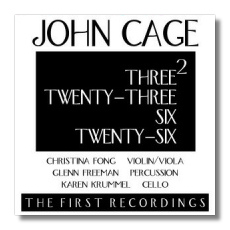
The Internet's Premier Classical Music Source
Related Links
- Cage Reviews
- Latest Reviews
- More Reviews
-
By Composer
-
Collections
DVD & Blu-ray
Books
Concert Reviews
Articles/Interviews
Software
Audio
Search Amazon
Recommended Links
Site News
 CD Review
CD Review
John Cage

- Three2
- Twenty-three
- Six
- Twenty-six
Christina Fong, violin & viola
Glenn Freeman, percussion
Karen Krummel, cello
OgreOgress UPC 643157094623 DDD 61:14
The so-called "number pieces," of which there are around fifty, occupied John Cage during the last years of his life. Generally speaking, the "main" number indicates how many performers are required. The superscript, when present, indicates how many works have been written for this number of performers. In other words, Two6, which was written in 1992, was the sixth number piece written for two performers – in this case, violin and piano.
The four number pieces included here were composed between 1988 and 1991, and they have not been recorded until now. As is often the case with Cage, nothing is quite as it first appears to be. How does one reconcile the number of performers on this disc (you can count them, but there are three!) with the titles of the pieces and the label's statement "first recordings of final works for large string ensemble and percussion ensemble"? Playing the CD, one realizes that this has been accomplished by overdubbing – lots of it, I suppose! I think Cage would not have disapproved of this. Furthermore, one notes that Twenty-three lasts for twenty-three minutes, Twenty-six for twenty-six minutes, and Three2 (think of it, for the moment, as 3 x 3) for nine minutes. Six spoils the pattern by lasting for only three minutes! There might be an explanation for this, and it might be in the booklet notes to this CD, but the review copy OgreOgress sent me was a "no frills" production.
Cage is famous for silences, but these four number pieces are orgies of more or less continuous sound. In fact, I've seen the timbre of these pieces compared to electronic music in two different publications, and the comparison is a good one. When Cage wrote these works, I don't think he wanted listeners to think to themselves, "Say, that's a violin!" or "That's a rattle." Instead, I think he wanted their response to be "What an unusual sound that is! I want to hear where it goes and what it does." The difference between string timbres and percussion timbres is intentionally blunted here. Some of Fong's and Krummel's timbres sound like noise from a distant lumber mill. Freeman's percussion is expressive and similarly pictorial in effect. While listening to Three2, one reviewer found himself imagining the naughty nocturnal adventures of a cognac-drunk Santa Claus! Well, why not? The sounds on this CD intoxicate. They provoke, confuse, irritate, and finally reach equilibrium with the listener. This release contains music that is more drone-like than is usual for Cage (admirers of "trance" music might love it), and so I think of it as "late night Cage."
The performance and the engineering are beyond reproach.
Copyright © 2002, Raymond Tuttle




















